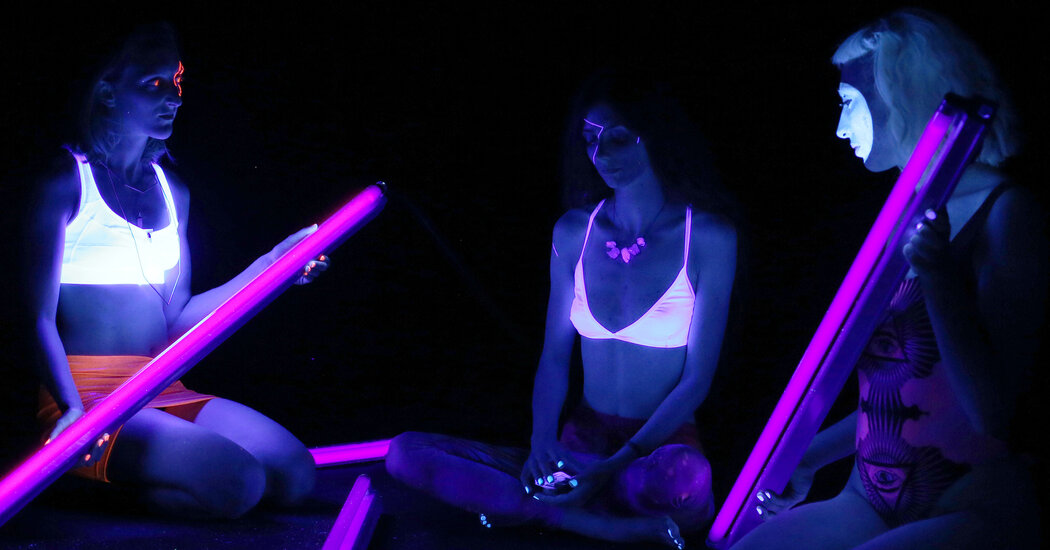
DORTMUND, Germany — “Let’s use smartphones and tarot cards to connect to spirits,” reads the writing on the wall, illuminated in soft ultraviolet light. “Let’s manufacture D.I.Y. devices to listen to invisible worlds.”
The incantations, printed as wallpaper, are part of the French artist Lucile Olympe Haute’s “Cyberwitches Manifesto,” an installation in a show called “Technoshamanism” that is at the Hartware MedienKunstVerein in Dortmund, Germany, through March 6, 2022. The group exhibition, which brings together the work of 12 artists and collectives, explores the connections between technology and esoteric, ancestral belief systems.
In our always-online lives, the supernatural is having a high-tech moment. Spirituality is all over our feeds: The self-help guru Deepak Chopra has co-founded his own NFT platform, witches are reading tarot on TikTok, and the A.I.-driven astrology app Co-Star has been downloaded more than 20 million times.
Dr. Jeffrey A. Tolbert, an assistant professor who researches belief and digital ethnography at Penn State Harrisburg has an explanation. “Because of the globalizing potential of the internet, people have access to belief traditions that were not easily accessible to them before,” he said. In the United States, a growing number of people identify as “spiritual” but not “religious,” he noted, adding that the internet allowed those people to discover, select and combine the spiritual traditions that most appealed to them.
The curator of “Technoshamanism,” Inke Arns, said on a recent tour of the show that contemporary artists also recognized the widespread presence of esoteric spirituality in the digital space. “I was asking myself, ‘How come, in different parts of the world, there is this strange interest in not only reactivating ancestral knowledge but bringing this together with technology?’” she said.
Often, for artists, the answer comes down to anxiety about the environment, Arns said. “People realize we are in a very dire situation,” she added, “from burning coal and fossil fuels. And it’s not stopping.” Ancient belief systems that were more in tune with nature, combined with new technology, were providing a sense of hope for artists in facing the climate crisis, she said.
While technological progress is often seen as damaging to the environment, artists, Indigenous activists and hackers were trying to reclaim technology for their own, esoteric purposes, said Fabiane Borges, a Brazilian researcher and member of a network called Tecnoxamanismo. That collective organizes meetings and festivals in which participants use devices including D.I.Y.-hacked robots to connect with ancestral belief systems and the natural world.
In the Dortmund show, a sense of hope shines through in several works that imagine a future for humans beyond Earth. Fifty prints by the British artist Suzanne Treister from the series “Technoshamanic Systems: New Cosmological Models for Survival” fill one wall of the museum, dreaming spiritual possibilities for the survival of our species.
Treister’s neat, colorful works on paper feature flying saucers and stars laid out in a kabbalah tree-of-life diagram, and blueprints for imagined scientific systems and extraterrestrial architecture. As billionaires like Elon Musk and Jeff Bezos look to outer space as the next frontier for human expansion, Treister has imagined a utopian alternative: space exploration as a process in which rituals and visions play as much of a role as solar power and artificial intelligence.
Many esoteric practices connect communities to a higher power, Arns said, which is why outer space features in so many contemporary artists’ explorations of spirituality. “It’s making a link between the microcosm and macrocosm,” she added, creating “an idea of a world that doesn’t only include the Earth.”
Technologists have, of course, come up with a more digital way to enter new worlds: virtual reality. Many of V.R.’s founders were interested in psychedelic experiences, a common feature of shamanic rituals. (The recent boom in ayahuasca ceremonies, where participants drink a psychoactive brew, shows that the attraction remains strong.) Researchers at the University of Sussex, in England, even used V.R. to attempt replicating a magic mushroom hallucination.
In the “Technoshamanism” show in Dortmund, several works offer the viewer trippy visions. Morehshin Allahyari’s V.R. work “She Who Sees the Unknown” conjures a sinister female djinn; at the artist’s request, the V.R. headset is worn lying down in the darkened space so that the malevolent spirit hovers menacingly over the viewer. Another work, experienced through augmented-reality glasses, leads the viewer through a meditative ritual in a gigantic papier-mâché shrine, weaving a spiraling light path with video holograms.
Rather than inventing their own virtual spiritual sites, other artists try to uncover the lost meaning of some that already exist. Tabita Rezaire, for example, whose website describes her as “infinity incarnated into an agent of healing,” is showing a film installation exploring megalithic stone circles in Gambia and Senegal. In a film playing on a flat-screen TV laid out on the museum floor, Rezaire investigates the original purpose of the ancient sites through documentary interviews with their local guardians, as well as with astronomers and archaeologists. Drawing on numerology, astrology and traditional African understanding of the cosmos, the interviews are superimposed into hypnotic CGI visualizations of outer space.
Technology and spirituality could also come together to preserve ancient cultural practices that might otherwise be lost, Borges, the researcher, said. She recalled that, at a 2016 festival organized by her network in Bahia, Brazil, teenagers with cellphones had recorded a full-moon ritual performed by members of the Pataxó, an Indigenous community. The footage, which showed Pataxó people speaking their ancient language in a trance, was later passed to local university researchers who are at work on expanding a dictionary, Borges said.
Interactions between new tools and esoteric practices can be seen across all sorts of mystical practices, Tolbert of Penn State said. “Technology has always been a part of spirituality,” he noted, citing psychic mediums hosting their own Facebook groups and ghost hunters using electromagnetic field detectors. “Most of them don’t see it, I think, as presenting any kind of a conflict,” he added.
Perhaps, then, as the “Cyberwitches Manifesto” suggests, there is more common ground than might be expected between the hackers and the witches, the programmers and the psychics. As Tolbert put it: “What is technology, if not a way for an individual person to uncover answers?”







